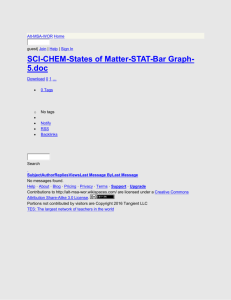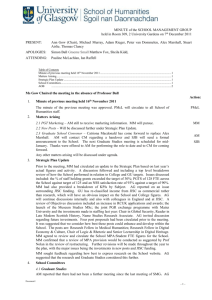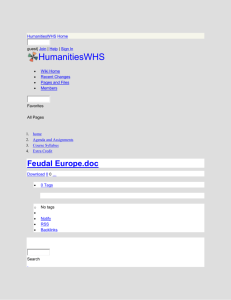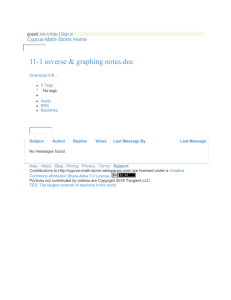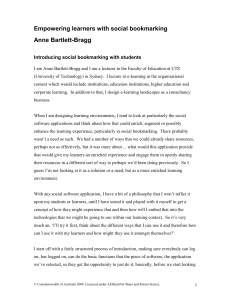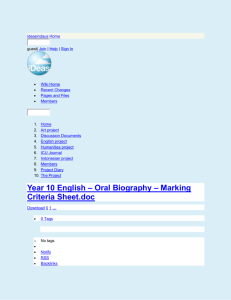introduction to Web 2.0
advertisement
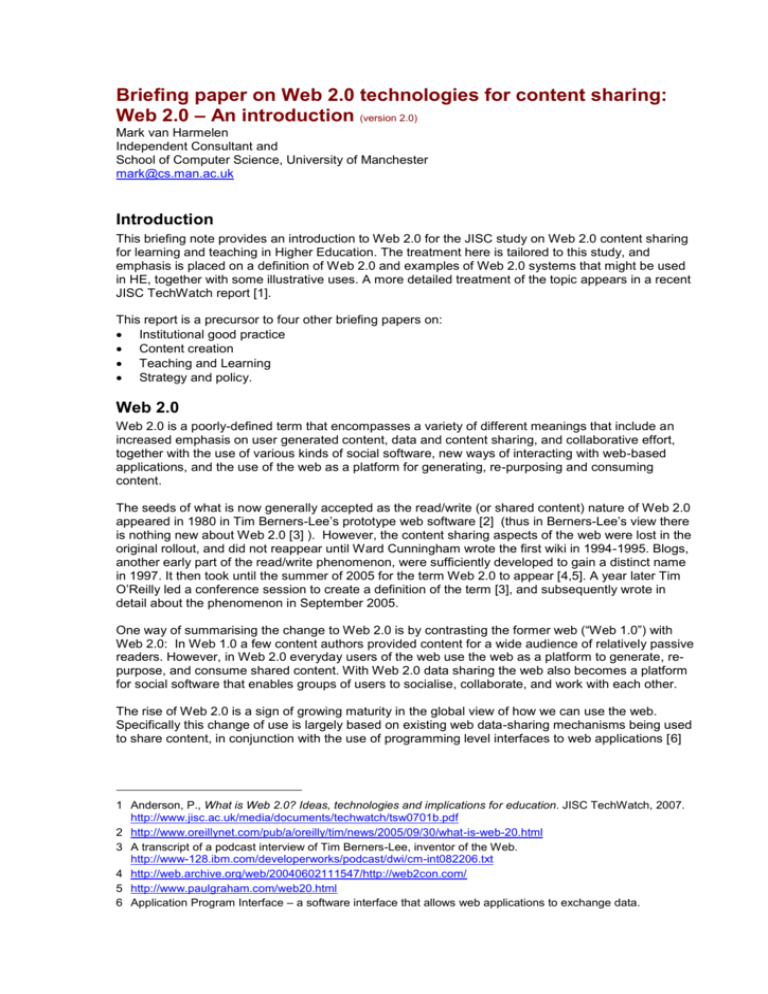
Briefing paper on Web 2.0 technologies for content sharing: Web 2.0 – An introduction (version 2.0) Mark van Harmelen Independent Consultant and School of Computer Science, University of Manchester mark@cs.man.ac.uk Introduction This briefing note provides an introduction to Web 2.0 for the JISC study on Web 2.0 content sharing for learning and teaching in Higher Education. The treatment here is tailored to this study, and emphasis is placed on a definition of Web 2.0 and examples of Web 2.0 systems that might be used in HE, together with some illustrative uses. A more detailed treatment of the topic appears in a recent JISC TechWatch report [1]. This report is a precursor to four other briefing papers on: Institutional good practice Content creation Teaching and Learning Strategy and policy. Web 2.0 Web 2.0 is a poorly-defined term that encompasses a variety of different meanings that include an increased emphasis on user generated content, data and content sharing, and collaborative effort, together with the use of various kinds of social software, new ways of interacting with web-based applications, and the use of the web as a platform for generating, re-purposing and consuming content. The seeds of what is now generally accepted as the read/write (or shared content) nature of Web 2.0 appeared in 1980 in Tim Berners-Lee’s prototype web software [2] (thus in Berners-Lee’s view there is nothing new about Web 2.0 [3] ). However, the content sharing aspects of the web were lost in the original rollout, and did not reappear until Ward Cunningham wrote the first wiki in 1994-1995. Blogs, another early part of the read/write phenomenon, were sufficiently developed to gain a distinct name in 1997. It then took until the summer of 2005 for the term Web 2.0 to appear [4,5]. A year later Tim O’Reilly led a conference session to create a definition of the term [3], and subsequently wrote in detail about the phenomenon in September 2005. One way of summarising the change to Web 2.0 is by contrasting the former web (“Web 1.0”) with Web 2.0: In Web 1.0 a few content authors provided content for a wide audience of relatively passive readers. However, in Web 2.0 everyday users of the web use the web as a platform to generate, repurpose, and consume shared content. With Web 2.0 data sharing the web also becomes a platform for social software that enables groups of users to socialise, collaborate, and work with each other. The rise of Web 2.0 is a sign of growing maturity in the global view of how we can use the web. Specifically this change of use is largely based on existing web data-sharing mechanisms being used to share content, in conjunction with the use of programming level interfaces to web applications [6] 1 Anderson, P., What is Web 2.0? Ideas, technologies and implications for education. JISC TechWatch, 2007. http://www.jisc.ac.uk/media/documents/techwatch/tsw0701b.pdf 2 http://www.oreillynet.com/pub/a/oreilly/tim/news/2005/09/30/what-is-web-20.html 3 A transcript of a podcast interview of Tim Berners-Lee, inventor of the Web. http://www-128.ibm.com/developerworks/podcast/dwi/cm-int082206.txt 4 http://web.archive.org/web/20040602111547/http://web2con.com/ 5 http://www.paulgraham.com/web20.html 6 Application Program Interface – a software interface that allows web applications to exchange data. that allow flexibility in reusing data at a programmatic level, and the adoption of communications protocols [7] that allow specialised data exchange. Web 2.0 and media convergence Although it is out of the scope of the current study full the implications of Web 2.0 for learning and teaching will eventually need to be viewed in the light of media convergence. The contemporaneous growth of Web 2.0 co-occurs with increased media convergence, particularly in respect of broadband communications, telephony and the broadcast media. Several interesting developments are on the horizon: Although we do not think that there will ever be a total end to professionally produced and editorialised media channels, media convergence heralds the end of broadcast media as pure dissemination-only mechanisms – part of a Web 2.0 style movement towards greater user participation in and repurposing of broadcast output in a ‘Media 2.0’ style. The increased bandwidth offered by 3G telephony will encourage a move from the desktop and the desktop browser to mobile devices and browsers. Content will be created, shared and consumed on mobile devices. Ubiquitous computing, computing that is always around us, and always on, will change our everyday digital and media environments; mediating the world in new ways. Web 2.0 Software One easy way to approach the subject of Web 2.0 is to look at the software that is commonly thought of as Web 2.0 software. Individual systems are hosted on a server and accessed across the web via a browser; they may be interchangeably be called Web 2.0 systems, Web 2.0 services, or Web 2.0 applications. For the purposes of this study we define Web 2.0 systems [8] to include the types of system discussed below. For those interested in a comprehensive list of Web 2.0 systems with educational applications we recommend the excellent “Back to school with Web 2.0” series [9]. Blogs (originally known as weblogs): A blog is a system that allows a single author (or sometimes, but less often, a group of authors) to write and publicly display time-ordered articles (called posts). Readers can add comment to posts. Example uses: A group of bloggers using their individual blogs can build up a corpus of interrelated knowledge via posts and comments. This can, e.g., be a group of learners in a class, encouraged and facilitated by a teacher, or might be a group of relatively dedicated life-long learners. Teachers can use a blog for course announcements, news and feedback to students. Blogs can be used with syndication technologies (below) to enable groups of learners and teachers to keep track of new posts. Wikis: A wiki is a system that allows one or more people to build up a corpus of knowledge in a set of interlinked web pages, using a process of creating and editing pages. The most famous wiki is Wikipedia. Example uses: Wikis can be used for the creation of annotated reading lists by one or more teachers. 7 Many communication protocols and data sharing formats for the web are expressed in a language called XML. 8 Except in this footnote, we omit the deeper technology components of the Web 2.0 equation, for example AJAX, various additional non-HTML protocols, and web based APIs allowing interoperability. Please see the TechWatch study [1] for introductory information on these. 9 http://www.solutionwatch.com/512/back-to-school-with-the-class-of-web-20-part-1/ Parts 2 and 3 are linked to early in the post. See also http://itredux.com/office-20/database/. Wikis can be used in class projects, and are particularly suited to the incremental accretion of knowledge by a group, or production of collaboratively edited material, including material documenting external activities such as group projects. Wikis can be used by teachers to supply scaffolding for writing activities – thus in a group project a teacher can supply page structure, hints as to desirable content, and then provide feedback on student generated content. Students can flag areas of the wiki that need attention, and provide feedback on each other’s writing. Social bookmarking: A social bookmarking service provides users the ability to record (bookmark) web pages, and tag those records with significant words (tags) that describe the pages being recorded. Examples include del.icio.us and Bibsonomy. Over time users build up collections of records with common tags, and users can search for bookmarked items by likely tag. Because items have been deemed worthy of being bookmarked, social bookmarking services can sometimes be more useful than search engines for finding Internet resources. Using tags, users can find other users who use the same tag and who are likely to be interested in the same topic(s). In some social bookmarking systems, users with common interests can be added to an individual’s own network to enable easy monitoring of the other users’ tagging activity for interesting items. Syndication (below) can be used to monitor a single user’s or all users’ tagging activity that uses interesting tags. Example uses: Teachers and learners can build up collections of resources, and with a little ingenuity can also use social bookmarking systems to bookmark resources that are not on the web. In this way it is easy to build up reading lists and resource lists. These may, with the use of multiple tags, be structured into sub-categories. Groups of users with a common interest can team together to use the same bookmarking service to bookmark items of common interest. If they have individual bookmarking accounts, they all need to use the same tag to identify their resources [10]. Media-sharing services: These services store user-contributed media, and allow users to search for and display content. Besides being a showcase for creative endeavour, these services can form valuable educational resources. The most compelling examples include YouTube (movies) and Flickr (photos), Slideshare (presentations), DeviantArt (art work), and Scribd (documents). The last is particularly interesting as it provides the ability to upload documents in different formats and then, for accessibility, to choose different download formats, including machine-generated speech. Example uses: Distribution and sharing of educational media and resources. For example, an art history class could have access to a set of art works via a photo sharing system. Flickr allows for annotations to be associated with different areas of an image and for comments to be made on the image as a whole, thereby facilitating teacher explanations, class discussion, and collaborative comment. It could be used for the example above. For Flickr, FlickrCC [11] is a particularly useful ancillary service that allows users to find Creative Commons licensed images that are freely reusable as educational resources. Instructional videos and seminar records can be hosted on video sharing systems. Google Video allows for longer higher quality videos than YouTube, and contains a specific genre of educational videos [12]. Social networking systems: Systems that allow people to network together for various purposes. Examples include Facebook and MySpace (for social networking / socialising), LinkedIn (for professional networking), and Elgg (for knowledge accretion and learning). Key to social networking systems are the ability to describe oneself, and the notions of friends, ranking, and communities. The ability to record friends is common in social networking systems. Users can traverse and navigate social networks via series of friends. Ranking and communities are more selectively implemented. 10 Thus, e.g., members of the JISC Users and Innovation community (Emerge) are using the del.icio.us tag jisc_emerge http://del.icio.us/jisc_emerge to tag resources of common interest. 11 http://www.bluemountains.net 12 http://video.google.com/videosearch?q=genre%3Aeducational Some of this genre has been hijacked to promote particular political points of view. Ranking (often of user contributions) by community members allows for reputations to be built and for individuals to become members of good standing; this can be an important motivator for the individual contributions that make for a thriving community. Community facilities allow for (sub-) communities of members with common interests to be established, and allow for nurturing and growth of common interests in an environment that allows a degree of insulation from the general hubbub of system activity. Example uses: The use of Elgg at the University of Brighton is discussed in the Institutional good practice briefing paper. There is a recent report of either Facebook or MySpace being officially adopted by a teacher and used course related purposes instead of a VLE because students would not engage in the VLE. LinkedIn acts, at a professional level, as a model of educational use in the way in which it can be used to disseminate questions across the community for users seeking particular information. Other varieties of social networking systems are used at a professional level for community learning and act as potential models for educational use: e.g. Confluence, a corporate wiki system with a social network focus, is currently being used in a pilot project to promote the spread of knowledge in Local Government communities. Collaborative editing tools: These allow users in different locations to collaboratively edit the same document at the same time. As yet most of these services do not allow for synchronous voice or video communication, so the use of third party synchronous communication systems are often needed to co-ordinate editing activity. Examples are Google Docs & Spreadsheets (for text documents and spreadsheets), and Gliffy (for diagrams). Example use: For collaborative work over the web, either edited simultaneously or simply to share work edited by different individuals at different times. Syndication and notification technologies: In a world of newly added and updated shared content it is useful to be able to easily keep up to date with new and changed content, particularly if one is interested in multiple sources of information on multiple web sites. A feed reader (sometimes called an aggregator) can be used to centralise all the recent changes in the sources of interest, and a user can easily use the reader/aggregator to view recent additions and changes. Behind the scenes this relies on protocols called RSS (Really Simple Syndication) and Atom to list changes (these lists of changes are called feeds, giving rise to the name feed reader). A feed reader regularly polls nominated sites for their feeds, displays changes in summary form, and allows the user to see the compete changes. Podcasting is a way in which a listener may conveniently keep up-to-date with recent audio or video content. Behind the scenes podcasting is a combination of audio or video content, RSS, and a program that deals with (a) RSS notifications of new content, and (b) playback or download of that new content to a personal audio/video player. Example uses: Feed Readers enable students and teachers to become aware of new blog posts in educational blogging scenarios (see above), to track the use of tags in social bookmarking systems (also above), to keep track of new shared media (above), and to be aware of current news, e.g. from the BBC. Example uses for podcasting are to supply audio or video copies of lectures, to supply videos of experimental procedures in advance of lab sessions, and to supply audio for foreign language learning and teaching purposes (tutorial material and/or exemplar recordings of native speakers). Notes Many Web 2.0 systems are hybrids of the above, and common mechanisms of friends, tags, communities and feeds are used in many different kinds of Web 2.0 applications. The field is growing fast, and many new hybrids and kinds of systems are frequently created. Social Software All of the above systems can be grouped under the convenient label of social software, software that exists to facilitate group processes. If anything the importance Web 2.0 is that it is inextricably intertwined with the growth of social software. Bricolage and mashups Inherent in Web 2.0 software is some ability for users to join together, personalise and configure systems according to their own needs. Thus, for example, blog users can change the contents of the margins of their posts to allow access to information (e.g. their del.icio.us posts) and even communication facilities (e.g. access to Skype call users via ‘Skype Me’ buttons). The act of experimentally building new artefacts in this way is known as bricolage [13]. Sometimes bricolage facilities are built into Web 2.0 application configuration tools, but sometimes bricolage relies on some HTML knowledge. In the latter case bricolage is beyond the competence of most current users. Web 2.0 also adds the notation of mashups, where users can mix and repurpose data for their own needs. The current state of the art is represented by Yahoo Pipes [14], a web-based facility that allows users to mix and process web-based data without needing to know a programming language. Conclusion Web 2.0 will have profound implications for learners and teachers in formal, informal, work-based and life-long education. Web 2.0 will affect how HEIs go about the business of education, from learning, teaching and assessment, through contact with school communities, interfacing with industry, and maintaining contact with alumni. These and further issues and implications for UK HE are discussed in the accompanying briefing papers. 13 Turkle, S., and Papert, S. Epistomolical Pluralism and the Revaluation of the Concrete. http://www.papert.org/articles/EpistemologicalPluralism.html 14 http://pipes.yahoo.com

